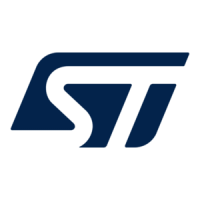DocID018909 Rev 11 1115/1731
RM0090 Ethernet (ETH): media access control (MAC) with DMA controller
1232
Store-and-Forward mode
• Option to forward under-sized good frames
• Supports statistics by generating pulses for frames dropped or corrupted (due to
overflow) in the Receive FIFO
• Supports Store and Forward mechanism for transmission to the MAC core
• Automatic generation of PAUSE frame control or back pressure signal to the MAC core
based on Receive FIFO-fill (threshold configurable) level
• Handles automatic retransmission of Collision frames for transmission
• Discards frames on late collision, excessive collisions, excessive deferral and underrun
conditions
• Software control to flush Tx FIFO
• Calculates and inserts IPv4 header checksum and TCP, UDP, or ICMP checksum in
frames transmitted in Store-and-Forward mode
• Supports internal loopback on the MII for debugging
33.2.2 DMA features
• Supports all AHB burst types in the AHB Slave Interface
• Software can select the type of AHB burst (fixed or indefinite burst) in the AHB Master
interface.
• Option to select address-aligned bursts from AHB master port
• Optimization for packet-oriented DMA transfers with frame delimiters
• Byte-aligned addressing for data buffer support
• Dual-buffer (ring) or linked-list (chained) descriptor chaining
• Descriptor architecture, allowing large blocks of data transfer with minimum CPU
intervention;
• each descriptor can transfer up to 8 KB of data
• Comprehensive status reporting for normal operation and transfers with errors
• Individual programmable burst size for Transmit and Receive DMA Engines for optimal
host bus utilization
• Programmable interrupt options for different operational conditions
• Per-frame Transmit/Receive complete interrupt control
• Round-robin or fixed-priority arbitration between Receive and Transmit engines
• Start/Stop modes
• Current Tx/Rx Buffer pointer as status registers
• Current Tx/Rx Descriptor pointer as status registers
33.2.3 PTP features
• Received and transmitted frames time stamping
• Coarse and fine correction methods
• Trigger interrupt when system time becomes greater than target time
• Pulse per second output (product alternate function output)

